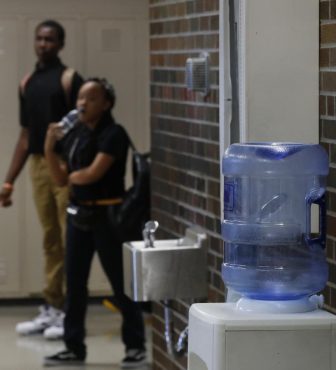
Some 50,000 Detroit public school students started the 2018 school year drinking water from coolers after the discovery of elevated levels of lead or copper in water from fountains. Image: AP Photo/Paul Sancya
By Sophia Brandt
Some Michigan schools have been making the switch from traditional water fountains to ones with a water fill-up station and filter to ensure safe drinking water for their children.
Switching water fountains allows students to fill water bottles and provides a visible marking of filtration, such as a light showing filter status. Filters keep contaminants, such as lead, out of water.
Now, new legislation proposes plans to install filtered water fillup stations and test water to keep safe drinking water in all schools and child care centers, implementing the state’s clean drinking water law.
Sens. Sylvia Santana, D-Detroit, and John Cherry, D-Flint, are the lead sponsors.
Because of the major impact of the Flint water crisis on Michigan, safe drinking water has become a public health, environmental and political priority.
After the discovery of lead contamination in Flint water, the city’s schools closed their drinking fountains. The Elon Musk Foundation in California paid for 136 bottle-filling stations that were installed last year in the schools.
The proposal, which is awaiting a vote in the Senate, would require fountains to have a light or other way to show if the filter is working.
Testing is important to check for contaminants such as lead, which can get into drinking water through lead pipes or stagnant water, said Holly Gohlke, a school drinking water specialist for the Department of Environment, Great Lakes and Energy.
According to the American Academy of Pediatrics, even low levels of lead in blood have a negative impact on children’s brain development, leading to inability to pay attention and harm academic achievement.
“There still are a lot of lead pipes, especially in old school buildings,” Gohlke said.
Part of the School Drinking Water Program’s goals is to reduce the health risks of lead as much as possible.
“The use of filters can assist us in that ultimate goal,” Gohlke said.
Filters can safely remove contaminants from drinking water, says the Michigan Lead Safe website.
Stagnant water that has been sitting for some time, is another source of lead contamination.
“Schools have a lot of times where water isn’t being used in the building, especially for long weekends or breaks. The water gets really stagnant, and you can’t always rely on people to run the water during those times,” Gohlke said.
The legislation would require each school and child care center to implement a water management plan, with testing every few months.
Cosponsors include Sens. Erika Geiss, D-Taylor; Roger Victory, R-Hudsonville; Joseph Bellino Jr., R-Monroe; Rick Outman, R-Six Lakes;and Paul Wojno, D-Warren; and Kristen McDonald Rivet, D-Bay City.
The estimated cost of the program is around $58 million, according to a legislative analysis, although the final cost would be less because many schools have already changed systems on their own.
“Lead can be variable in the drinking water. One day it may test negative, another it may test positive,” Gohlke said.
Due to the variations, having a plan to test the water is important, she said.
“You can’t smell, see or taste lead in water,” Gohlke said, and there is no way to know unless you collect and analyze a sample of the water.
Sophia Brandt reports for Capital News Service.